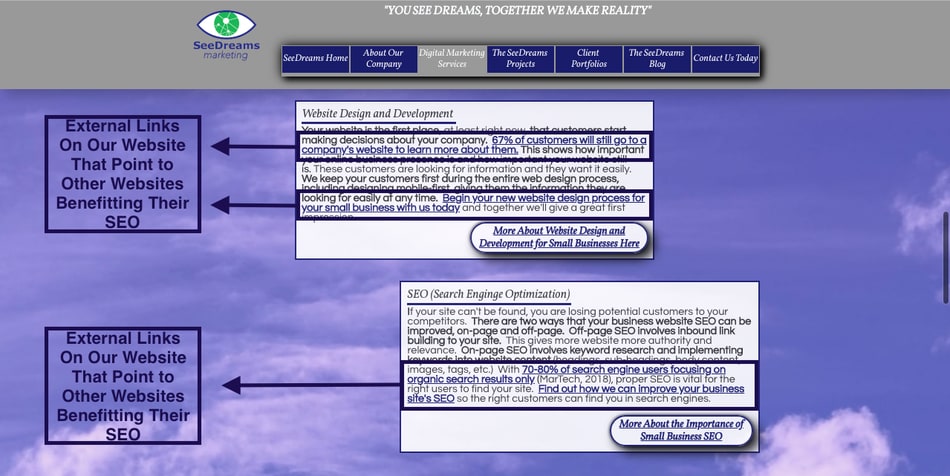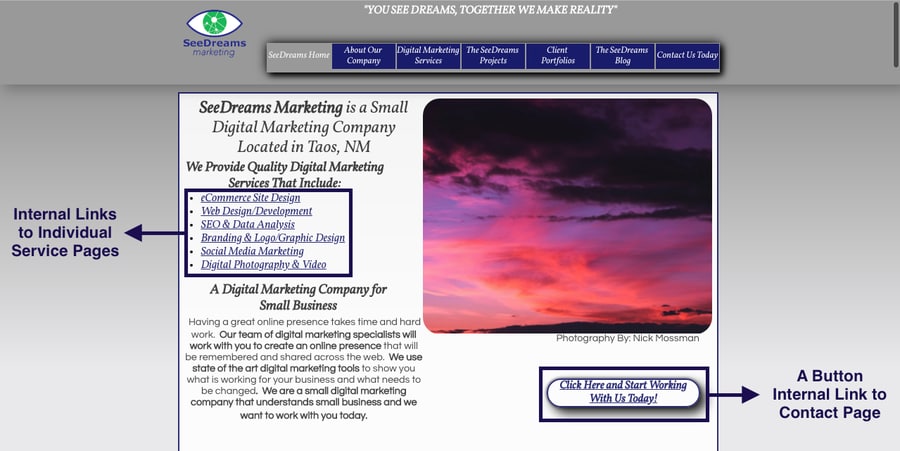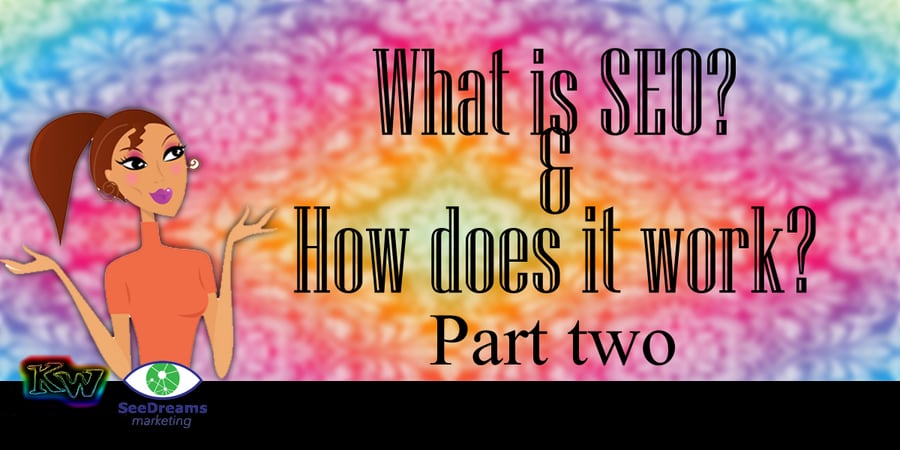Welcome back to “What is SEO and How it Works: Part Two”. In last week’s article, “What is SEO and How it Works: Part I,” we discussed the definition of SEO and what elements are involved in your On-Page SEO. Today we will be looking at what Off-Page SEO is and what changes will affect your SEO in 2019, so let’s get started!
Off-Page SEO
Continuing from Part I, we have taken care of our visual aspect of SEO with our On-Page SEO, now it’s time to work on the aspects of SEO that we can’t see or our Off-Page SEO. Off-Page SEO involves link building, both from external websites and internally to boost relevance and authority of your website. It’s not as complicated as it sounds and once understood you will be able to develop your own link building strategy that’s strong and organized. Let’s take a closer look!
- Backlinks or External Links-The first kind of link and link building we will go over are backlinks. These are links that you gain from other websites that find content from your website that is worth linking to. These links begin doing two things for your website:
- They begin to build your domain authority, a kind of grading scale for your website.
- They tell the crawler that you have quality content and that it has relevance and authority for a specific topic.
One of the best ways to describe how these links work is to think of a popularity contest. However, there are bonus “points” that you gain with higher quality backlinks. To understand how this works let’s take Website A and Website B and compare their backlinks.
Example #1:
Website A has a good number of backlinks linking back to their website. According to their metrics they have 100 links from other websites. However, the more we look into the details of the links, we notice that most of these links are coming from sources with lower domain authority (Amateur blogs, newer websites with low domain authority, websites that don’t relate to the topic at all, etc.).
Conclusion: As long as Website A’s competitors have a lower quantity of links and the same lower quality links, Website A has a better chance of ranking higher than its competitors. But, we will see what can happen if a competitor has higher quality links, enter Website B.
Example #2:
Website B is a competitor to Website A and when you look at the metrics, the link count of Website B is significantly lower than that of Website A only having 50. However, Website B has been putting out some very high quality content and the majority of the links it does have are from very reputable and highly recognized sources (Industry leaders with high domain authority, reputable news sources, influencer bloggers, etc.). Because Website B has gained this recognition from these high quality sources, it gains “bonus points”. Website B now has some of the domain authority from these other sources, giving more relevance and authority.
Conclusion: Website B has a solid chance to rank higher than Website A and any other competitors, even though it’s link count is low. The high quality of the links that are linking to Website B show that the content is of high quality, delivers the correct information and is highly relevant to the specific topic “boosting” its ranking.

As you can see, ideally you want a good mix of links, both lower and higher quality. Lower quality links does not mean bad links, it just means that the source of the link isn’t as recognized as others and can still reach a large number of users. High quality links just means that the source of the link is a highly trusted website. Remember: You always want to create high quality content, but don’t forget to provide content for customer’s in every part of the buyer’s journey.
SeeDreams Tip: Keep track of the links that are linking to your website. Some of these links you don’t want followed because it can hurt your SEO (spam score). By adding a “No Follow” command to these links you tell the crawler not to follow the link to the source, keeping your SEO strong.
Now that we understand what backlinks are and how they help your SEO, it’s time to look at the internal links of your website and why they are also important.
- Internal Links-These are the links that connect the pages of your website to each other and lead the user through the buying funnel. Not only are these links important to the user experience, but the search engine crawlers also use these links to measure the relevancy and authority of each page of your website. With clear and well organized internal link structure, the crawler can easily travel through your website and understand what each page is about. The following example will help further your understanding on how this works, let’s check it out!
Example:
Let’s say we have come to a website and we have landed on their homepage. As we begin to learn about the company we are researching, there is a link that leads us to the “About” page. Based on the link, we have expectations that if we click this link, we will be taken to the “About” page of the website. After reading more about the company, there is another link that you see that now will take you the “Product or Services” page. Again, we expect that when this link is clicked we will see what services or products are available. As we read about the product or services there’s another link that goes to an individual page for a specific product or service. Can you see a pattern yet? As these links are placed throughout your website you create a “web” of links that are clearly defined and will take the user and crawler alike to the page it says it will. The clearer and more organized your internal link structure is, the better your ranking score will be because you show relevancy and authority that your website is about what is says it’s about.

We can see why our internal links are important, not only for the crawlers to validate what each page is and what it’s about, but it makes a huge difference for your website’s user experience. By knowing where they will be going next, you begin to gain their trust and make your website easy to navigate.
Now that we know about the different kinds of links that are involved in our Off-Page SEO, let’s talk about our link building strategy!
- Link Building-As you begin your link building, you will develop two different strategies. One for external link building and one for internal link building. Each one is a very different strategy, but both involve your content strategy. Let’s take a closer look at how to develop these two strategies!
- Backlink or External Link Strategy-Developing a strong backlink strategy will involve a few things. Creating high quality content that attracts attention on it’s own is the best place to start. The main benefit this carries, it’s free link building. By providing content that people want to share with others without having to ask, you begin to show that you are knowledgeable and trustworthy. A second approach to your link building strategy is reaching out to influencers or top bloggers in your industry. By having influencers write guest articles for or about your company, you gain trust and authority from target audiences that you otherwise wouldn’t have access to. Don’t get caught off guard and plan a budget as there will most likely be a charge for the content from these entities. A third approach to your link strategy is to contact clients and vendors you already work with and discuss a link trade. What this means is that by providing a link to their website they will provide a link pointing back to your website. This is a great way to gain backlinks that are industry related and it is shared advertising that benefits both companies. Again, plan a budget just in case. Ideally you want to incorporate all three of these strategies into your link building strategy to have the best opportunities possible to gain quality links.
- Internal Link Strategy-Working on your internal link strategy should be focused on flow. Do your internal links lead the user and crawler where they’re supposed to go? Do the links have Anchor Text that tell the user and crawler what is on the next page? If you answered “No” to either of these questions, you need to fix your internal links. What was that? What’s Anchor Text?
Anchor Text is the text that is made into a link that points to a page on a website. Keywords are used in Anchor Text for internal linking to give more relevance to the linked page helping page authority when used.
Now that we know what Anchor Text is, we can incorporate it into the links on your website. As you develop your link strategy, make sure you include your keyword strategy into links. With keywords as part of your Anchor Text, you build the relevance and authority of your pages helping each page rank better for specific keywords.
SeeDreams Tip: A blog is a great way to help your internal link building strategy. As you post more content on your blog, you create new opportunities to link to other parts of your website. Plus, it’s a great way to get even more high quality content on your website! Always remember, every new blog post is a new page on your website. Your internal link building is essentially endless!
Awesome! You have made it through What is SEO and How it Works! These two articles are the foundations that will help you develop a solid SEO strategy for your website. Look at every aspect of your website and make the appropriate changes that will help your website show up for the right audience at the right time. Along with your SEO strategy, don’t forget to monitor your metrics. This data is also important to your SEO strategy. It let’s you know what is working, what is not and where changes should be made in the strategy. Remember: SEO is never ending. It changes quickly, so be diligent about staying updated for the best edge in SEO.
SeeDreams Tip: Always develop your SEO strategy for the users first and then the crawlers. In the end, the users are the ones interacting with your website and are the ones that need to be engaged. Plus, with the search engine algorithms always changing to be more human, you’ll already have a strategy that is human focused!
SEO in 2019
As we all know, search engines depend on an algorithm to determine which web pages are shown in the Search Engine Results Page or SERP. This algorithm is always being updated and will change how SEO works from time to time. In 2019 the algorithm is adding in more human aspects that will affect your ranking. Let’s take a look at some of these changes!
- Website Engagement-A new factor that is part of the new algorithm change is how users engage with your website. The more time users spend on your website is now considered as part of your rank score. What this means for your SEO in 2019 is that high-quality content should be a top priority. Remember: Create high-quality content for target personas in every stage of the buyer’s journey to keep users interested in the information your website provides.
- Mobile Optimization-We all know that the use of mobile devices with access to the web is becoming more and more popular and if your website isn’t mobile optimized it will now affect your rank score. Your website will now be penalized if it’s not mobile optimized as part of your User Experience score. Because the search algorithms are made to be as human as possible and the use of mobile keeps increasing every year, mobile optimization is becoming very important to your SEO strategy.
SeeDreams Tip: Perform an honest audit of your website on various mobile devices and see what it looks like. Make the necessary changes to create a solid User Experience to help your SEO strategy.
Now that you are fully equipped with the knowledge of what SEO is and how it works, start creating your own SEO strategy with confidence. Always keep your customers in mind and concentrate on creating high-quality content. By using these best practices, you are on your way to having a great SEO strategy!
Resources
https://searchengineland.com/5-seo-trends-that-will-matter-most-in-2019-307641


